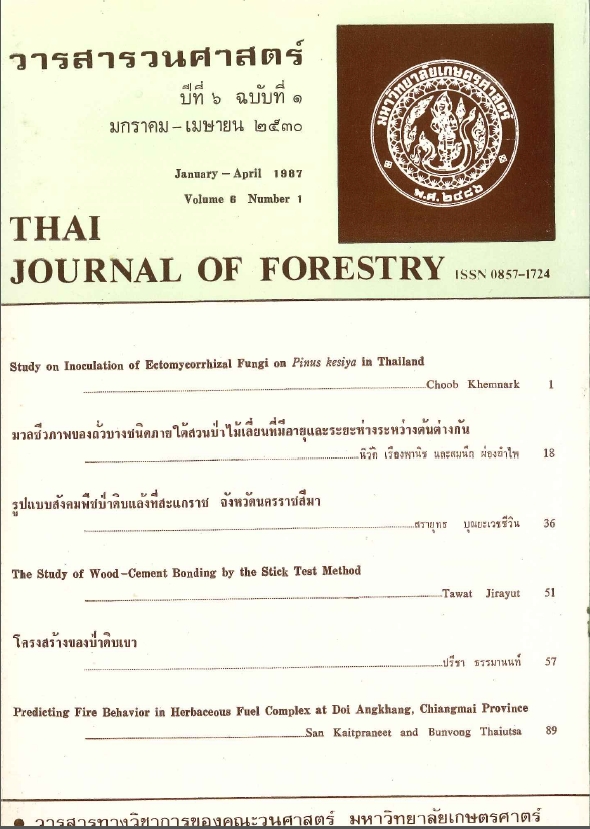มวลชีวภาพของถั่วบางชนิดภายใต้สวนป่าไม้เลี่ยนที่มีอายุและระยะห่างระหว่างต้นต่างกัน
Main Article Content
บทคัดย่อ
จากการทดลองหามวลชีวภาพของพืชในวงศ์ถั่ว ๓ ชนิด คือ ถั่วเซนโตรมา ถั่วเซอราโตร และถั่วแลปแลปภายใต้สวนป่าไม้เลี่ยนที่มีระยะห่างระหว่างต้น ๔ x ๔ เมตร (ปลูกปี ๒๕๒๓) และ ๒ x ๘ เมตร (ปลูกปี ๒๕๒๔) ที่สวนป่าองค์พระจังหวัดสุพรรณบุรี ตั้งแต่เดือนพฤษภาคม พ.ศ. ๒๕๒๗ ถึงเดือนมิถุนายน พ.ศ. ๒๕๒๘ โดยใช้วิธีทดลองแบบ Completely randomized factorial design. ผลการวิเคราะห์ข้อมูลมวลชีวภาพบนดินปรากฏว่า มีความแตกต่างอย่างมีนัยสำคัญทางสถิติ (P <0.01) ทั้งระหว่างชนิดถั่ว และระหว่างระยะห่างระหว่างต้นโดยถั่วเซนโตรมา มีมวลชีวภาพเฉลี่ยต่อปีสูงสุดคือ ๑,๑๑๖.๒๕ กิโลกรัมต่อเฮกแตร์ ส่วนถั่วเซอราโตรมีมวลชีวภาพเฉลี่ย ๘๐๔.๕๒ กิโลกรัมต่อเฮกแตร์ และถั่วแลปแลป ๑๕๘.๐๖ กิโลกรัมต่อเฮกแตร์ ปริมาณมวลชีวภาพของถั่วที่เก็บแต่ละครั้งจะผันแปรไปตามปริมาณน้ำฝน และสำหรับในช่วงฤดูแล้งเฉพาะถั่วเซนโตรซีมาและถั่วเซอราโตรเท่านั้นที่ยังคงเขียวชะอุ่มอยู่ สำหรับสวนป่าที่ปลูกระยะห่าง ๒ x ๘ เมตร มีมวลชีวภาพเฉลี่ยจากทั่วทุกชนิดเท่ากับ ๘๙๗.๖๓ กิโลกรัมต่อเฮกแตร์ ซึ่งมากกว่าสวนป่าที่ปลูกด้วยระยะห่าง ๔ x ๔ เมตร ที่มีมวลชีวภาพรวมโดยเฉลี่ยเพียง ๕๐๖.๒๕ กิโลกรัมต่อเฮกแตร์ ถ้าหากต้องการประยุกต์หลักการด้านวนเกษตร เข้าจัดการพื้นที่สวนป่าก็ควรใช้ระยะปลูก ๒ x ๘ เมตร จะเหมาะสมกว่า ๔ x ๔ เมตร
Downloads
Article Details

อนุญาตภายใต้เงื่อนไข Creative Commons Attribution-NonCommercial-NoDerivatives 4.0 International License.
ข้าพเจ้าและผู้เขียนร่วม (ถ้ามี) ขอรับรองว่า ต้นฉบับที่เสนอมานี้ยังไม่เคยได้รับการตีพิมพ์และไม่ได้อยู่ในระหว่างกระบวนการพิจารณาตีพิมพ์ลงในวารสารหรือสิ่งตีพิมพ์อื่นใด ข้าพเจ้าและผู้เขียนร่วม (ถ้ามี) ยอมรับหลักเกณฑ์และเงื่อนไขการพิจารณาต้นฉบับ ทั้งยินยอมให้กองบรรณาธิการมีสิทธิ์พิจารณาและตรวจแก้ต้นฉบับได้ตามที่เห็นสมควร พร้อมนี้ขอมอบลิขสิทธิ์ผลงานที่ได้รับการตีพิมพ์ให้แก่วารสารวนศาสตร์ คณะวนศาสตร์ มหาวิทยาลัยเกษตรศาสตร์ กรณีมีการฟ้องร้องเรื่องการละเมิดลิขสิทธิ์เกี่ยวกับภาพ กราฟ ข้อความส่วนใดส่วนหนึ่ง หรือ ข้อคิดเห็นที่ปรากฏในผลงาน ให้เป็นความรับผิดชอบของข้าพเจ้าและผู้เขียนร่วม (ถ้ามี) แต่เพียงฝ่ายเดียว และหากข้าพเจ้าและผู้เขียนร่วม (ถ้ามี) ประสงค์ถอนบทความในระหว่างกระบวนการพิจารณาของทางวารสาร ข้าพเจ้าและผู้เขียนร่วม (ถ้ามี) ยินดีรับผิดชอบค่าใช้จ่ายทั้งหมดที่เกิดขึ้นในกระบวนการพิจารณาบทความนั้น”


